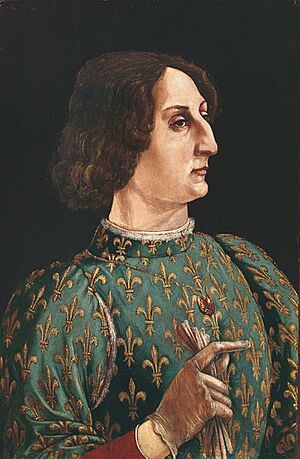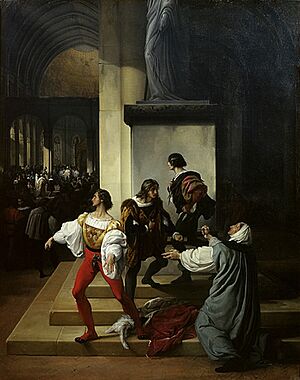Galeazzo Maria Sforza facts for kids
Quick facts for kids Galeazzo Maria Sforza |
|
|---|---|

Galeazzo Sforza, by Piero Benci, Uffizi Gallery
|
|
| Duke of Milan | |
| Reign | 20 March 1466 – 26 December 1476 |
| Predecessor | Francesco I Sforza |
| Successor | Gian Galeazzo Sforza |
| Born | 24 January 1444 Commune of Fermo (now in Italy) |
| Died | 26 December 1476 (aged 32) Milan, Duchy of Milan (now in Italy) |
| Spouse | Dorotea Gonzaga Bona of Savoy |
| Issue |
|
| House | Sforza |
| Father | Francesco I Sforza |
| Mother | Bianca Maria Visconti |
Galeazzo Maria Sforza (born January 24, 1444 – died December 26, 1476) was the fifth Duke of Milan. He ruled from 1466 until 1476. He was known for being a harsh and sometimes unfair ruler.
He was born to Francesco Sforza and Bianca Maria Visconti. His father, Francesco, was a famous military leader. Francesco became the Duke of Milan in 1450.
Galeazzo Maria Sforza married into the Gonzaga family. After his first wife, Dorotea Gonzaga, passed away, he married Bona of Savoy. People often described him as a ruler who made many poor decisions.
Contents
Life of Galeazzo Maria Sforza
Galeazzo Maria Sforza was born in Fermo, a town in Italy. He was the first son of Francesco Sforza and Bianca Maria Visconti. When his father died in 1466, Galeazzo was in France. He was leading a military group to help King Louis XI.
His mother called him back home to Milan. Sforza traveled back to Italy using a fake name. This was important because he had to pass through lands controlled by an enemy, the Duke of Savoy. The Duke of Savoy even tried to harm him. Galeazzo entered Milan on March 20, 1466. The people welcomed him as their new duke.
In his first years as duke, Galeazzo and his mother ruled together. However, he later took full control and removed her from power in Milan.
Duke Sforza's Support for Music
Galeazzo Maria Sforza was very famous for supporting music. He provided money and encouragement for his chapel. This chapel became one of the most well-known music groups in Europe.
Many composers came to Milan to work for him. These included musicians from the Franco-Flemish region. They sang and wrote different types of music for the duke. Some famous musicians who worked for Sforza were Alexander Agricola and Johannes Martini.
After Sforza was killed, many of these singers left Milan. They found new jobs in other cities. This helped improve music in places like Ferrara.
The Assassination of Duke Sforza
Three main people were involved in Sforza's death. They were Carlo Visconti, Gerolamo Olgiati, and Giovanni Andrea Lampugnani. All three were important officials in the Milanese court.
Lampugnani, who came from a noble Milanese family, led the plan. He was upset because the duke had not helped him in a land dispute. This made Lampugnani's family lose a lot of property. Visconti and Olgiati also disliked the duke for their own reasons.

The conspirators carefully watched Sforza's movements. They decided to act on December 26, 1476. This was the day after Christmas, a special day for Saint Stephen. The plan was to kill him at the Santo Stefano church during mass.
About thirty friends supported the three men. They waited in the church for the duke to arrive. When Galeazzo Sforza came, Lampugnani knelt before him. After a few words, Lampugnani suddenly attacked and killed Sforza. Olgiati and Visconti quickly joined in the attack. A servant of Lampugnani's also helped.
In the chaos that followed, most of the attackers escaped. However, Lampugnani got caught in some church cloth. A guard then killed him.
Aftermath of the Assassination
The government quickly acted to find those responsible. The public also wanted justice.
The conspirators had not thought much about what would happen after their crime. They were caught within a few days. Visconti and Olgiati were soon found and executed. The servant who helped in the attack was also executed. These executions happened in public.
During questioning, the conspirators said they were encouraged by Cola Montano. He was a scholar who had left Milan months before. He held a grudge against the duke. Olgiati famously said, "Death is bitter, but glory is eternal, the memory of my deed will endure."
This assassination may have influenced another plot. This was the Pazzi conspiracy in Florence. That plot tried to remove the Medici family from power.
Galeazzo Maria Sforza's Children
Galeazzo and his second wife, Bona of Savoy, had four children:
- Gian Galeazzo Sforza (1469–1494): He became duke after his father died. He married his cousin Isabella of Aragon, Duchess of Milan.
- Hermes Maria Sforza (1470–1503): He was the Marquis of Tortona.
- Bianca Maria Sforza (1472–1510): She married Philibert I, Duke of Savoy and later Maximilian I, Holy Roman Emperor.
- Anna Sforza (1476–1497): She married Alfonso I d'Este.
Galeazzo also had several children with his mistress, Lucrezia Landriani:
- Carlo (born 1461)
- Caterina Sforza (1462–1509): She married three times.
- Two more children.
He had one child with his mistress Lucia Marliani:
- Ottaviano Maria Sforza (1475–1548): He became the Bishop of Lodi.
He also had other children with unknown women, including:
- Chiara: She married Count Pietro dal Verme in 1480.
See also
 In Spanish: Galeazzo María Sforza para niños
In Spanish: Galeazzo María Sforza para niños

